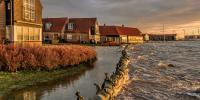Almost a third of Denmark is threatened by water from the sky, sea and ground

Both globally and nationally, we've had a year with many worrying climate records in 2023, and the wet weather and storms of recent months have brought climate change close to home. Rainwater and seawater have given us images of flooded houses, roads and fields. The human and economic consequences are significant.
"Water from the sky, sea and ground already threatens 600,000 homes in various ways. But if we consider a changing climate in the way we use our land, we can both create a more climate-resilient landscape and protect the places where we live," says Amanda Vallgårda, Analyst at CONCITO.
The new analysis The impact of climate change on future land use (in Danish) shows that almost a third of the Danish area is already exposed to various forms of extreme weather. This corresponds to the area of Zealand, Funen and Lolland combined.
A changing climate means that in the future, we can expect these weather events to happen more often and become more severe. When Storm Pia hit Denmark last December, we experienced a storm surge of a magnitude that we typically only see every 20 years. With climate change, by the end of this century we can expect to see such storm surges several times a year
Climate change forces us to rethink our land priorities
In its analysis, CONCITO emphasizes that local conditions will determine how much an area will be affected and what the consequences will be. However, it is clear that for a very large part of the Danish areas, we should consider whether the current and future use takes into account a changing climate.
"The question is whether the considerations we currently make for cultural values, aesthetics, private investment, nature and other societal values are still the right ones. We won't be able to preserve everything as it is today, so we need to decide what is important to prioritize and then adjust our land use accordingly," says Amanda Vallgårda.
It is possible to use climate adaptation in a positive way that fulfills several considerations at the same time. This could be restoring natural environments in a river valley, which will act as a large sponge during floods and provide space for animals and plants that currently have a hard time in Denmark. It could also be agriculture using perennial crops that can withstand both droughts and floods, and act as water storage after extreme rainfall. Finally, pulling buildings back from the coast will make room for the unique Danish coastal nature.
A climate resilient Denmark through sensible land use
A thorough understanding of climate change, the landscape and the water cycle is a prerequisite for future land use planning. Our ability to cope with rising water volumes will therefore be crucial to our ability to manage climate change in Denmark. This is where the design of the landscape plays a key role.
"We must avoid creating future problems for ourselves by building in the most climate vulnerable areas. We need to make sure we coordinate different land use needs so that nature, recreation and climate protection areas are considered together. And we must ensure flexibility so that we also have the opportunity to handle the challenges we haven't foreseen," says Tage Duer, Project Manager at CONCITO
The new analysis is part of a larger CONCITO project on future land use. Overall, the project indicates that there are benefits to be gained by considering climate adaptation together with other considerations in the landscape.
"It is therefore important that climate adaptation considerations are integrated into a future land use strategy," emphasizes Tage Duer.




